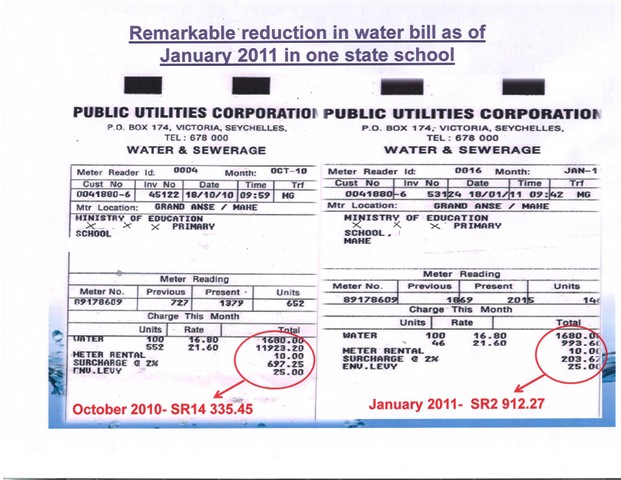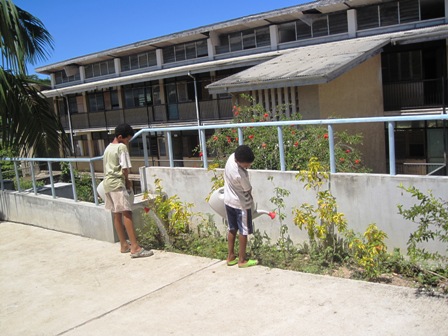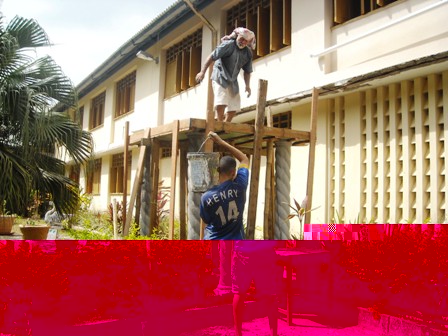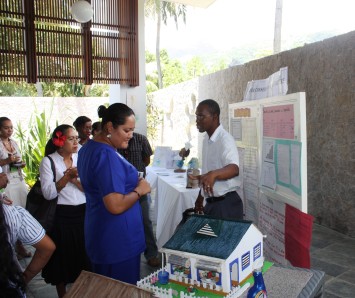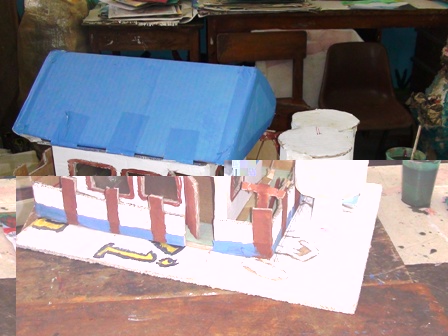Schools fight climate change with rainwater |14 January 2012
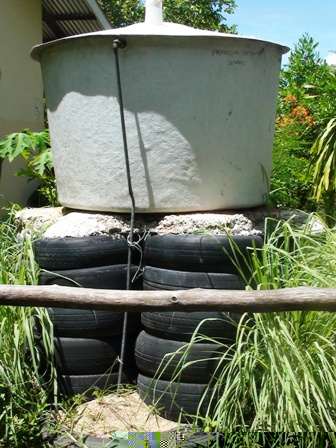
These include sea level rise, rising sea surface temperatures and changes in rainfall patterns, causing short periods of heavy downpours during the rainy season and severe droughts during the dry season.
These effects have adverse impacts on the health and functioning of ecosystems and consequently, on the wellbeing of humans as the changes affect the social and economic systems that are central to human existence.
This problem of water scarcity is further compounded by the ever increasing demand for water, caused by increased economic and social development as well as population growth.
To address this, the country has invested heavily in the construction of reservoirs and desalination plants, but this has not completely solved the problem due to continued development.
Instead, to some extent, it has increased the use of fossil fuel which emit green house gases.
Risen water demand in schools
Increased school population and the local educational campaign to green school grounds, and the continuous health campaign to wash hands frequently to reduce the spread of diseases have resulted in increased demand for water in schools.
This has not only been a big challenge for schools during the dry season, but it has also resulted in higher school water bills.
As part of the environmental education programme, the education programme unit (EE) started the School Rainwater Harvesting Project (SRWHP) with the help of local and international donors, especially from the United Nations Environment Programme (UNEP).
The project was launched in 2009 in 10 schools and is now jointly coordinated by the Environmental Education Unit in the department of Environment and the Public Education and Community Outreach in the Environment Department.
Due to good publicity and success stories in schools, the project is now in great demand at community level where Sustainability for Seychelles – a non-governmental organisation (NGO) – is working to help people from the community harvest rain water for domestic use.
Its objectives were to harvest rain water from school roofs so as to meet the needs of selected schools and to reduce the cost of water bills, educate school children on the impact of climate change on our water resources and on the methods used to adapt to climate change, raise awareness among the general public on climate change impacts on the Seychelles and on rainwater harvesting as a means of adapting to water problems caused by climate change and finally, share the water harvesting experiences of the schools with other organisations.
The SRWHP proved that rainwater harvesting can be used to increase water security at schools. Schools taking part in the project were collecting and storing over 2,000 litres of extra water per month. During severe drought, schools depended much on the water stored, and in the case of one secondary school, the headteacher said during the 2011 drought, it was their “only source of water”. It was also noted that when there was a sudden disruption of water during school hours – for example when the Public Utilities Corporation was fixing pipes – the water acted as a backup.
School saves R13,000 a month
The project also helped the schools economically. All schools which took part in the project said their water bills went down, with one school reporting an monthly drop of R13,423.18, proving that in less than a year, schools involved recovered the rainwater systems’ installation cost from the savings made in water bills.
Money saved can now be invested in other teaching and learning projects. The project also helps schools to investigate where they were wasting water most and what measures can be taken to reduce it. This analysis was done through a water audit at the beginning of the project.
Apart from benefitting the schools economically through water bill savings, it was also noted that it helped in gardening. It therefore proved its benefit in sustaining the natural ecosystem and biodiversity, showing how rainwater harvesting can help in irrigation to increase food production. In most secondary schools, the water was used by students learning agriculture to sustain their plants even during the dry periods.
Water harvested was also used to promote health and hygiene as students used the water to wash up after physical education or recreational activities. When water is restricted, such hygienic practices are often limited, said one of the teachers.
During severe or persisting drought, rainwater stored at school was used to meet water shortages. People in the community have also tried to set up the system at their homes. There was a remarkable number of requests from communities wishing to know how such projects can be adapted at home level.
The requests were so many that a local NGO, Sustainability for Seychelles, stepped in to help implement the project at community level.
In some schools parents helped build the structure for water tanks and start the project there. They also attended climate change presentations. In one school, students used their creativity by recycling old car tyres to prepare structures to support tanks.
Stepped up interest
Getting students and teachers involved at all levels during the project helped build their capacity to handle environmental and sustainable development issues.
It also boosted ownership of the project and so got the support of the whole school population.
A series of workshops and presentations were organised for teachers on climate change, water and rainwater harvesting.
After workshops held during the school development planning sessions, teachers and students from two schools further exploited the project in the National Science and Technology Fair and both won prizes, with one of them winning the Most Environmentally Friendly Project award.
While doing the audit, students used mathematics to calculate the amount of water used daily at different sites in the schools. A maths teacher said such experience helped him learn about water consumption patterns and where people waste most water daily. In some schools these calculations and results were displayed in exhibitions.
It also helped the schools to identify systems which were not environmentally friendly, such as the automatic flushing urinals in boys’ toilets which flushed over 5 litres of water every 5-10 minutes.
This system was blocked. Water leaks were also identified and stopped.
The project therefore helped school management teams to be more alert and conscious of water wastage and conservation.
Built skills
At the La Digue school, students at secondary level said the project improved their vocational skills which include welding, masonry and painting when constructing the tank’s structure.
Teachers said science and maths were the subjects most used when implementing the project. Most of them mentioned climate and climate change as other topics in which they learnt most.
A few also mentioned social science and at secondary level, vocational subjects were also mentioned. Poems and painting on the theme were produced during language and art classes.
Most schools adopted variable pedagogies that were more action oriented learning, where the global problem of climate change was localised to address the urgent needs of the children and teachers. This was evident in the science fair project as well as those where students and teachers were involved in installing the tanks. There was also a shift from teacher-centered to a more action learning approach.
As it was more focused on project- based learning, it assisted in solving environmental issues through creativity, innovation and critical thinking which are important requirements in education for sustainable development.
This in turn will hopefully better equip young people to prepare themselves for future global challenges, especially in regards to climate change, a gain in other important skills in Education for Sustainable Development (ESD).
Schools taking part in the project were used as demonstration centres by NGOs involved. This was evident at La Digue school, where an NGO, which is trying to up-scale the project at community level, used the school as a demonstration centre for their community workshops.
Parents involved even asked for the technical assistance of teachers and students in the installation of a system at their homes, showing the importance of educational institutions as research centres and the important roles they can play in raising awareness at community level.
Education materials were developed for use in schools, which also saw the involvement of teachers and students in the process. The project has been used at regional and international forums such as those organised by the United Nations Environmental Scientific and Cultural Organisation and the United Nations Framework Convention on Climate Change as a means of best practices for climate change education and education for ESD.
Recently, the project was nominated among others from 10 developing countries worldwide, and was showcased at the UNFCCC’s Conference of the Parties held in Durban recently.
The Danish government was the main sponsor of the project, others being the Department of Education, the Environment Department, the Public Utility Cooperation, and other non-governmental organisations such as Seychelles Island Foundation, Sea Level Rise Foundation, and Sustainability for Seychelles.
Contributed by the Environment Education Unit and the Public Education and Outreach Division





